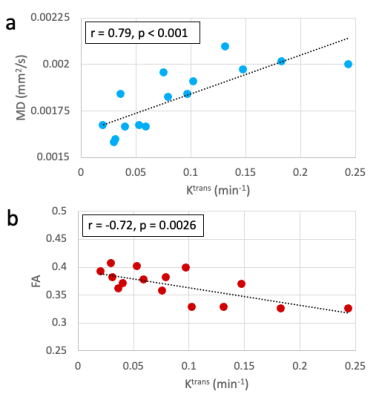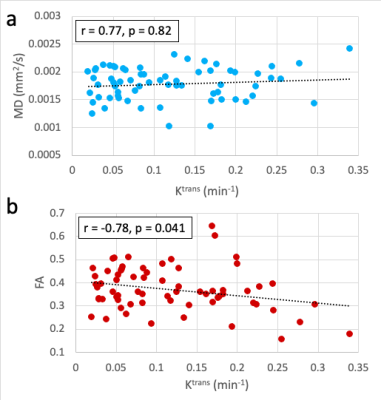Halston J.C. Sandford1, James W. MacKay2, Lauren E. Watkins1,3, Garry E. Gold1,3,4, Feliks Kogan1, and Valentina Mazzoli1
1Radiology, Stanford University, Stanford, CA, United States, 2University of East Anglia, Norwich, United Kingdom, 3Bioengineering, Stanford University, Stanford, CA, United States, 4Orthopaedic Surgery, Stanford University, Stanford, CA, United States
1Radiology, Stanford University, Stanford, CA, United States, 2University of East Anglia, Norwich, United Kingdom, 3Bioengineering, Stanford University, Stanford, CA, United States, 4Orthopaedic Surgery, Stanford University, Stanford, CA, United States
DTI is a promising tool for assessing intensity of synovitis in osteoarthritic knees without the use of gadolinium-based contrast agent, indicated by strong associations of the DTI parameters (MD and FA) with the DCE-MRI parameter Ktrans.

Figure 3: Within the whole synovium, (a) MD had a significant positive correlation with Ktrans and (b) FA had a significant negative correlation. For each standard deviation increase in Ktrans, MD increased by 1.3x10-4 mm2/s (approximately 7% of the median MD value) and FA decreased by 0.020 (approximately 6% of the median FA value).

Figure 4: Correlations between the diffusion parameters (MD and FA) and Ktrans within the 67 osteophyte-adjacent ROIs (defined as the intersection of the synovium segmentation and manually drawn regions around each osteophyte). (a) MD did not have a significant correlation with Ktrans (r = 077, p = 0.82) but (b) FA had a strong and significant negative correlation (r = -0.78, p = 0.0041).
